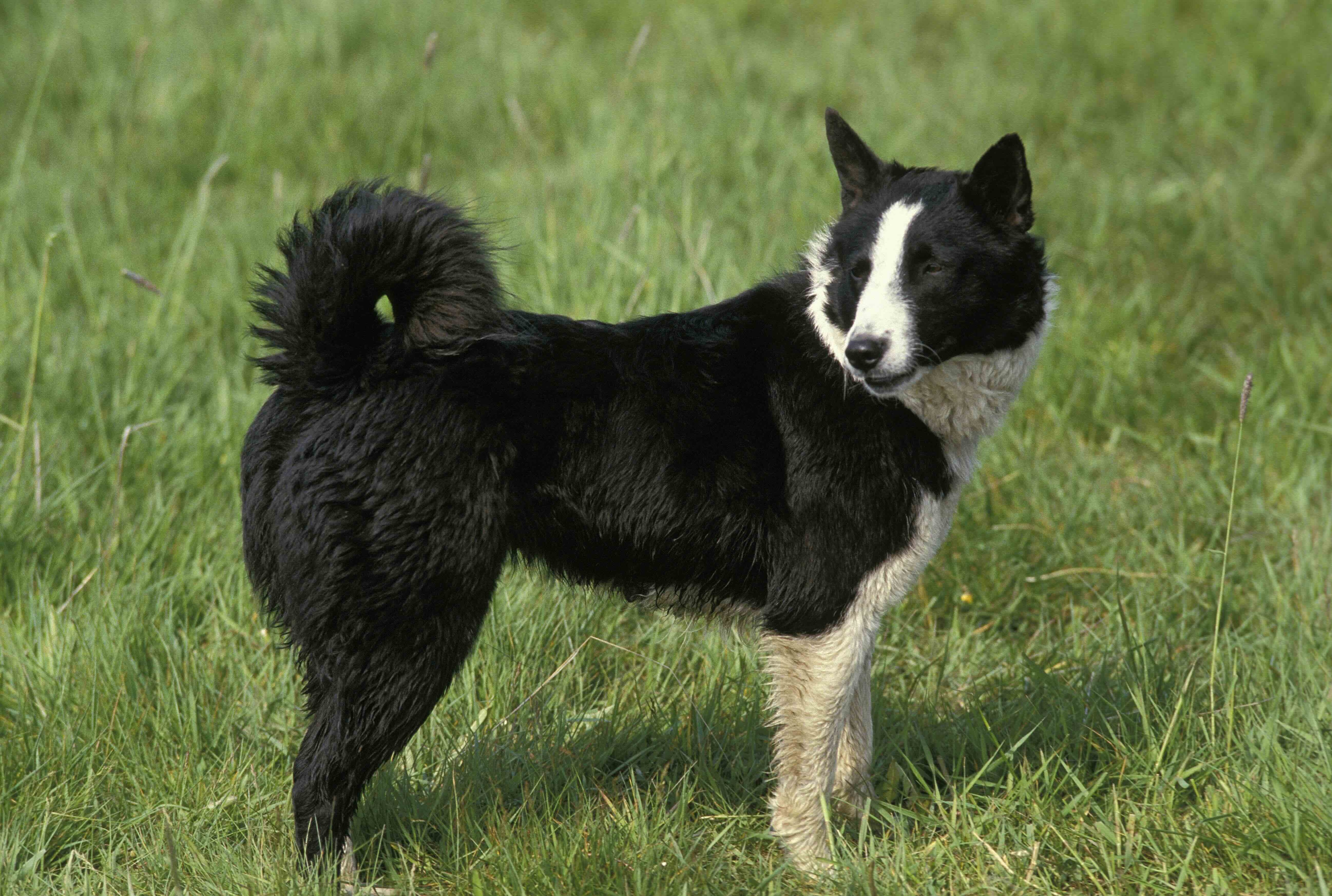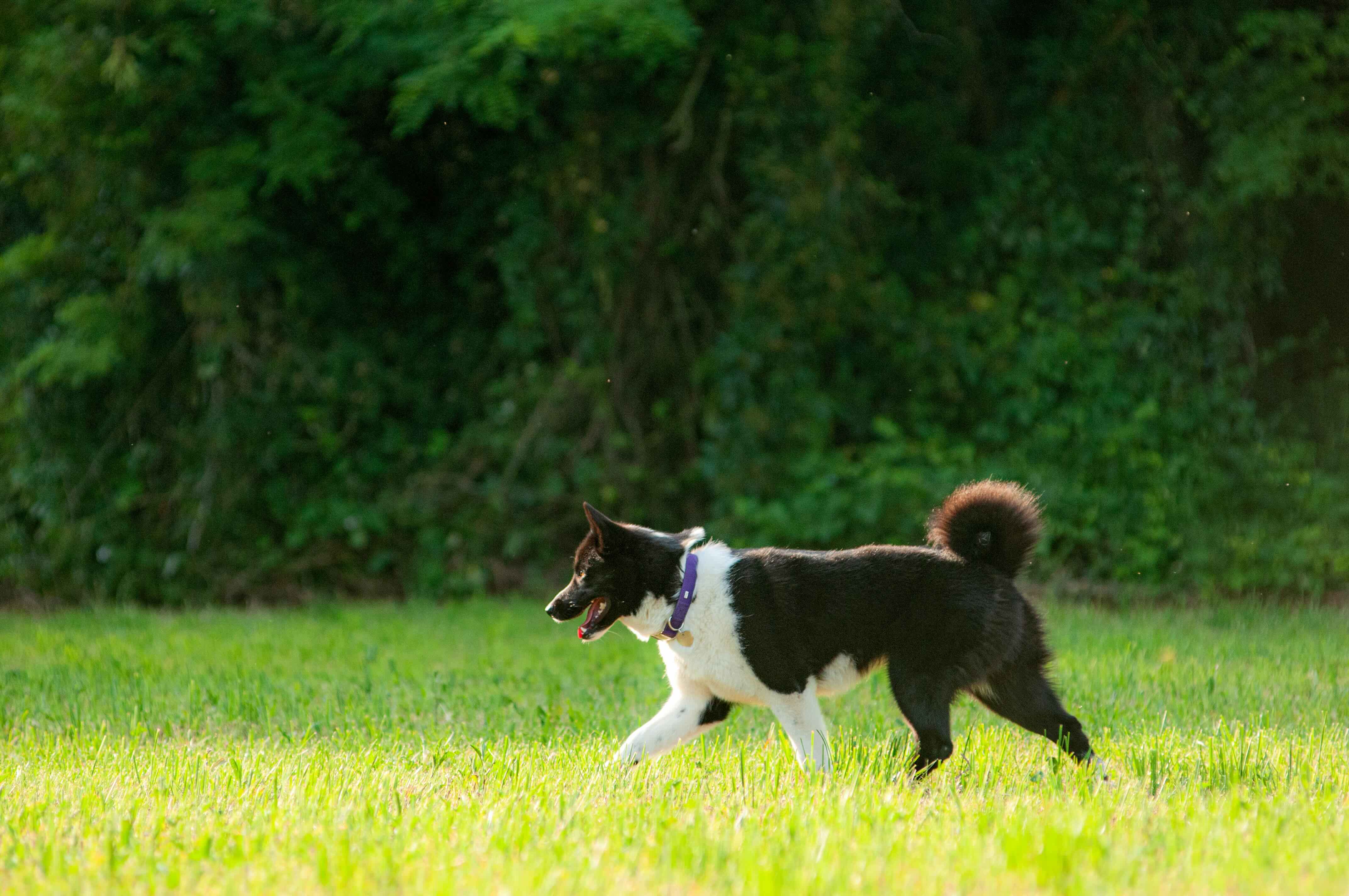Karelian Bear Dog
Adobe Stock/Tereza
The Karelian Bear Dog, pronounced ka-reel-ee-an, is a medium-sized hunting dog that originated in Finland.
Standing 19–23.5 inches tall at shoulder height and weighing 44–49 pounds, Karelian Bear Dogs are skilled hunters, according to the American Karelian Bear Dog Alliance (AKBDA). They can run for miles to take down large game, such as bears (hence their name), moose, and boar.
Because of their long history as hunting dogs, Karelian Bear Dogs are not often seen as family dogs and have an independent working spirit. In Washington state, the Washington Department of Fish and Wildlife uses Karelian Bear Dogs to protect the public when there is a bear or mountain lion threat.
They are known for their black-and-white dense coat, erect ears, and a tail that curves over their back.
Caring for a Karelian Bear Dog
Karelian Bear Dogs are intelligent dogs, but only experienced dog parents should bring this breed home. While every dog is an individual and breed only makes up about 9% of a dog’s behavior, the Karelian Bear Dog breed is known to be reserved and independent.
They’re best known as working dogs and have a moderate amount of energy.
Karelian Bear Dog Health Issues

The Karelian Bear Dog is a healthy dog breed. However, just like most dog breeds, they are predisposed to a few inherited medical conditions.
Progressive Retinal Atrophy
Progressive retinal atrophy (PRA) is a disease where the eye’s retina slowly degenerates when a Karelian Bear Dog is middle-aged, leading to blindness. There is no cure for PRA, but blind Karelian Bear Dogs can still live long, happy lives with proper care.
Cataracts
A cataract is a cloudy lens within the eye. Small cataracts are only visible with the aid of an ophthalmoscope tool your vet will use, while large cataracts can be easy to see, as the pupil will look completely white. The larger the cataract, the more significant the loss of vision.
Karelians can develop cataracts at a young age. Karelian Bear Dog breeders should not breed dogs with a family history of cataracts.
Unlike with PRA, surgery can remove cataracts and restore eyesight.
Hip Dysplasia
Hip dysplasia is an inherited orthopedic condition where the hip joint doesn’t properly align, leading to inflammation and pain in the joints (arthritis). Hip dysplasia can develop in one or both hip joints, and symptoms include:
-
Slowness to rise from a lying position
-
Bunny-hopping gait when running
-
Reluctance to run, jump, or go up or down stairs
-
Holding the affected leg out to the side
Hip dysplasia can be managed with joint supplements and certain medications. In serious cases, your Karelian Bear Dog may require surgery.
Dwarfism
Pituitary dwarfism is a rare inherited disorder caused by the pituitary gland not functioning properly, which leads to deficiencies in several hormones. Symptoms may include:
-
Stunted growth
-
Retained puppy coat
-
Delayed teething or lack of adult teeth
-
Prolonged heat cycles in females
-
Undescended testicle(s)
-
Hair loss
-
Thickened and/or pigmented skin
-
Kidney disease
Karelian Bear Dog puppies born with pituitary dwarfism require several diagnostic tests, including baseline blood work, a hormonal challenge, X-rays of the joints, and imaging of the pituitary gland. This condition is best managed with hormonal replacement therapy, but there is no cure.
Breeders should have a genetic screening done on their Karelian Bear Dogs to make sure they do not carry the gene for pituitary dwarfism.
Chondrodystrophy
Chondrodystrophy is an inherited skeletal disorder that leads to short legs and an elongated body. As a result of this condition, a Karelian Bear Dog can have limb deformities, intervertebral disc disease, joint instability and pain, and early onset arthritis.
Thankfully, most Karelian Bear Dogs with chondrodystrophy have a mild form of the condition and do not need treatment. Joint supplements, medical management, and surgery may be needed if your Karelian Bear Dog’s chondrodystrophy is severe.
Hypophosphatasia
Hypophosphatasia is another inherited skeletal disorder that leads to stunted growth, seizures, and mobility issues.
This is a severe medical condition, and there is no treatment available. Karelian Bear Dog puppies are often humanely euthanized soon after symptoms develop. Karelian Bear Dog breeders must have their dogs tested to make sure they do not carry the genetic mutation that causes hypophosphatasia.
What To Feed a Karelian Bear Dog
A Karelian Bear Dog puppy should be fed a medium-breed, high-quality puppy formula that’s calorie-dense to allow for proper growth. When your puppy turns 1, slowly transition their diet over five to seven days to an adult medium-breed dog formula. A Karelian Bear Dog should transition to a senior diet based on the age guidelines on the senior diet formula.
Talk to your vet about choosing the best dog food for your pet’s age and health. The brand and formula you choose needs to meet the nutritional standards set by the Association of American Feed Control Officials (AAFCO).
How To Feed a Karelian Bear Dog
Karelian Bear Dogs should be fed two meals a day: one in the morning and one in the evening. If your dog eats too quickly, use a slow feeder bowl at mealtime to prevent gastrointestinal upset.
How Much Should You Feed a Karelian Bear Dog?
Follow the feeding guidelines on the dog food packaging, and you can also consult your veterinarian to determine the proper portion size to feed your Karelian Bear Dog. The amount to feed your dog depends on their ideal body weight, life stage, and activity level.
Always measure the food for each meal to ensure you’re feeding your pup the right amount. Your Karelian Bear Dog’s daily diet should consist mostly of dog food (90%), with only 10% or less being dog treats.
Nutritional Tips for Karelian Bear Dogs
A healthy Karelian Bear Dog will meet their daily nutritional requirements by eating a high-quality dog food. As long as their diet is AAFCO-compliant, this breed shouldn’t need supplementation.
However, if your dog is diagnosed with hip dysplasia, chondrodysplasia, or another condition, your veterinarian may recommend starting your dog on a joint supplement, an omega-3 fatty acid supplement, and/or a prescription joint diet to minimize inflammation.
Behavior and Training Tips for Karelian Bear Dogs
Karelian Bear Dog Personality and Temperament

Karelian Bear Dogs prefer to be independent, and they’re often reserved around new people. Due to their strong hunting instincts, they may prefer to be the only pet at home because of their strong prey drive.
Karelian Bear Dogs have a moderate amount of energy and need ways to release this energy through exercise. They enjoy running in a fenced-in backyard, hunting, playing ball or Frisbee, and going on long walks. They also can do well in dog sports, such as agility and rally.
Karelian Bear Dog Behavior
The Karelian Bear Dog’s temperament and behavior are closely tied to their hunting history. They should never be let off-leash when outside, because their prey drive can make them prone to chasing whatever catches their eye.
This breed is also known to bark at anything they’re unsure of, which includes unfamiliar people and wild animals.
Karelian Bear Dogs prefer to be independent, and they’re often reserved around new people. Due to their strong hunting instincts, they may prefer to be the only pet at home because of their strong prey drive.
Karelian Bear Dog Training
Karelian Bear Dogs are not ideal for first-time pet parents because they can be difficult to train due to their independence.
Karelian Bear Dogs should be enrolled in puppy training classes and obedience training classes at a young age so they are easier to train and properly socialized. Socialization is important for all dogs, but especially for Karelian Bear Dog puppies so they learn to be well-mannered, confident, and calm when exposed to new stimuli.
Fun Activities for Karelian Bear Dogs
Karelian Bear Dog Grooming Guide
A Karelian Bear Dog has a double coat of medium-length, straight hair. Their coat is made of a harsh outer layer and a soft, dense inner layer. But despite its density, the coat is relatively easy to maintain.
Skin Care
This breed has no special skin care requirements aside from infrequent baths.
Ask your veterinarian when to bathe your Karelian Bear Dog, and contact your vet if you notice changes on your dog’s skin. Only use dog-friendly shampoos—never a human shampoo, which can damage your dog’s skin.
Coat Care
The Karelian Bear Dog’s black-and-white coat sheds a moderate amount. To minimize the amount of fur around the house and prevent a matted coat, brush your dog at least once or twice a week.
Eye Care
Because Karelian Bear Dogs are prone to PRA and cataracts, contact your veterinarian right away if you notice changes in your dog’s eyes or vision. This includes redness, discharge, cloudiness, a reluctance to go outside, or increased clumsiness. While PRA can’t be cured, cataracts can be treated.
Ear Care
Karelian Bear Dogs can occasionally have ear infections. Cleaning their ears with a routine ear cleaner every three to four weeks and after baths can keep their ears clean and less likely to develop infection.
Considerations for Pet Parents
Instead of being a family pet, Karelian Bear Dogs are better known for their remarkable hunting skills. They can be standoffish around strangers and willful when it comes to training, which makes this breed best suited for experienced pet parents.
The perfect home for a Karelian Bear Dog has a large, fenced-in yard where these dogs can run. That said, they can do well in small homes and apartments as long as they’re socialized, well-trained, and get lots of opportunities to be outside.
Karelian Bear Dog FAQs
Is a Karelian Bear Dog a good family dog?
Karelian Bear Dogs are not typically considered good family dogs. They prefer to be independent rather than with people.
Are Karelian Bear Dogs cuddly?
Karelian Bear Dogs are not the cuddly type. Instead, they prefer to be independent and ideally outside so that they can watch over their territory.
Are Karelian Bear Dogs rare?
Karelian Bear Dogs are common in Finland but rare in other parts of the world.
How long do Karelian Bear Dogs live?
Karelian Bear Dogs live 11–13 years on average, which is about the typical lifespan for a medium-sized dog.
